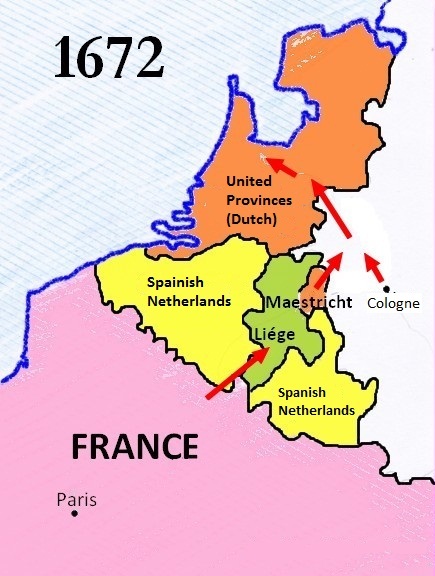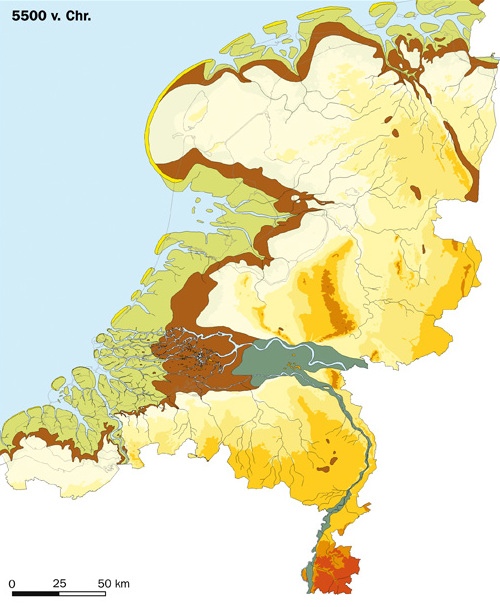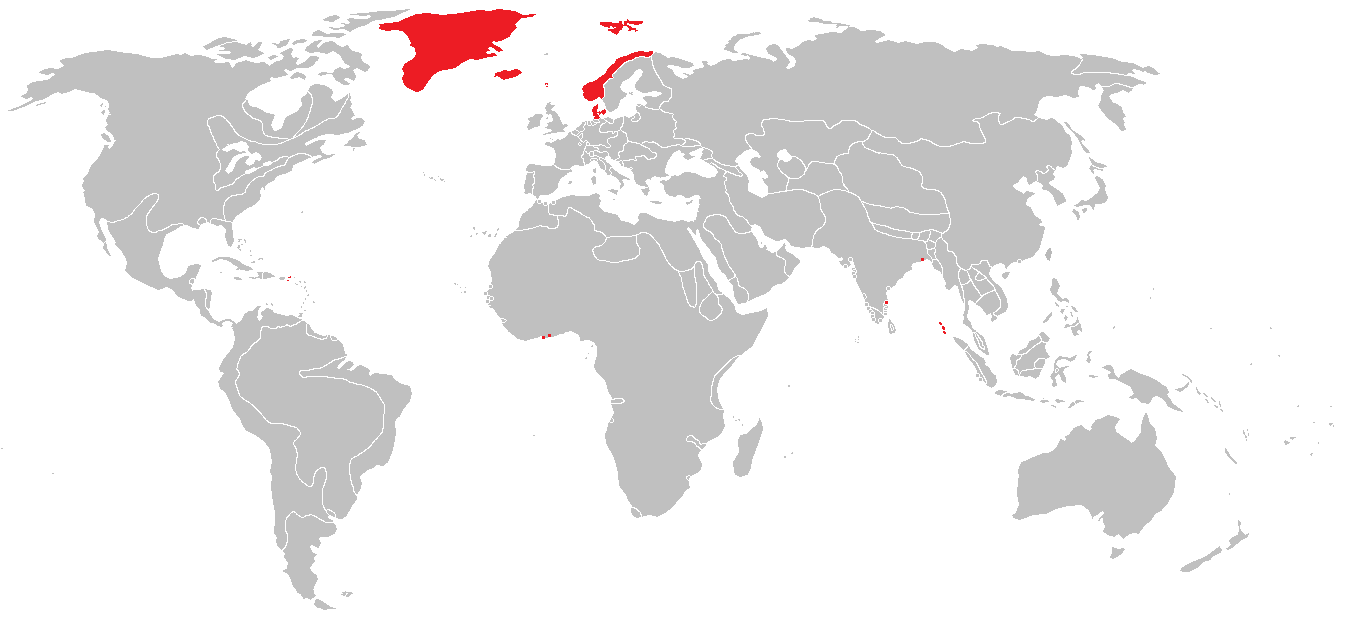|
Rampjaar
In Dutch history, the year 1672 is referred to as the nl, Rampjaar, label=none (Disaster Year). In May 1672, following the outbreak of the Franco-Dutch War and its peripheral conflict the Third Anglo-Dutch War, France, supported by Münster and Cologne, invaded and nearly overran the Dutch Republic. At the same time, it faced the threat of an English naval blockade in support of the French endeavor, though that attempt was abandoned following the Battle of Solebay. A Dutch saying coined that year describes the Dutch people as ("irrational"), its government as ("distraught"), and the country as ("beyond salvation"). The cities of the coastal provinces of Holland, Zealand and Frisia underwent a political transition: the city governments were taken over by Orangists, opposed to the republican regime of the Grand Pensionary Johan de Witt, ending the First Stadtholderless Period. By late July however, the Dutch position had stabilised, with support from Holy Roman Emperor Le ... [...More Info...] [...Related Items...] OR: [Wikipedia] [Google] [Baidu] |
Franco-Dutch War
The Franco-Dutch War, also known as the Dutch War (french: Guerre de Hollande; nl, Hollandse Oorlog), was fought between France and the Dutch Republic, supported by its allies the Holy Roman Empire, Spain, Brandenburg-Prussia and Denmark-Norway. In its early stages, France was allied with Münster and Cologne, as well as England. The 1672 to 1674 Third Anglo-Dutch War and 1675 to 1679 Scanian War are considered related conflicts. The war began in May 1672 when France nearly overran the Dutch Republic, an event still known as the ''Rampjaar'' or "Disaster Year". Their advance was halted by the Dutch Water Line in June and by late July the Dutch position had stabilised. Concern over French gains led to a formal alliance in August 1673 between the Dutch, Emperor Leopold I, Spain and Brandenburg-Prussia. They were joined by Lorraine and Denmark, while England made peace in February 1674. Now facing a war on multiple fronts, the French withdrew from the Dutch Republic, retaining ... [...More Info...] [...Related Items...] OR: [Wikipedia] [Google] [Baidu] |
History Of The Netherlands
The history of the Netherlands is a history of seafaring people thriving in the lowland river delta on the North Sea in northwestern Europe. Records begin with the four centuries during which the region formed a militarized border zone of the Romans in the Netherlands, Roman Empire. This came under increasing pressure from Germanic peoples moving westwards. As Roman power collapsed and the Middle Ages began, three dominant Germanic peoples coalesced in the area, Frisians in the north and coastal areas, Dutch Low Saxon, Low Saxons in the northeast, and the Franks in the south. During the Middle Ages, the descendants of the Carolingian dynasty came to dominate the area and then extended their rule to a large part of Western Europe. The region nowadays corresponding to the Netherlands therefore became part of Lower Lorraine, Lower Lotharingia within the Frankish Holy Roman Empire. For several centuries, lordships such as Duchy of Brabant, Brabant, County of Holland, Holland, Zeeland ... [...More Info...] [...Related Items...] OR: [Wikipedia] [Google] [Baidu] |
Third Anglo-Dutch War
The Third Anglo-Dutch War ( nl, Derde Engels-Nederlandse Oorlog), 27 March 1672 to 19 February 1674, was a naval conflict between the Dutch Republic and England, in alliance with France. It is considered a subsidiary of the wider 1672 to 1678 Franco-Dutch War. In the 1670 Secret Treaty of Dover, Charles II of England agreed to support an attack by Louis XIV of France on the Dutch Republic. By doing so, Louis hoped to gain control of the Spanish Netherlands, while Charles sought to restore the damage to his prestige caused by the 1667 Raid on the Medway. Under the treaty, Charles also received secret payments which he hoped would make him financially independent of the English Parliament. The French offensive in May and June 1672 quickly over-ran most of the Republic, with the exception of the core province of Holland, where they were halted by water defences. In early June, the Anglo-French fleet was badly damaged by the Dutch under Michiel de Ruyter at the Battle of Solebay, ... [...More Info...] [...Related Items...] OR: [Wikipedia] [Google] [Baidu] |
Orangism (Netherlands)
In the history of the Dutch Republic, Orangism or ''prinsgezindheid'' ("pro-prince stance") was a political force opposing the ''Staatsgezinde'' (pro-Republic) party. Orangists supported the Princes of Orange as Stadtholders (a position held by members of the House of Orange) and military commanders of the Republic, as a check on the power of the ''regenten''. The Orangist party drew its adherents largely from traditionalists – mostly farmers, soldiers, noblemen and orthodox Protestant preachers, though its support fluctuated heavily over the course of the Republic's history and there were never clear-cut socioeconomic divisions. History The coup of stadtholder Maurice against Oldenbarnevelt Orangism can be seen as a continuation of the political opposition between the remonstrants and counter-remonstrants during the Twelve Years' Truce (1609-1621). The Remonstrants were tolerant and republican, with a liberal view on biblical interpretation, no belief in predestination a ... [...More Info...] [...Related Items...] OR: [Wikipedia] [Google] [Baidu] |
First Stadtholderless Period
The First Stadtholderless Period or Era (1650–72; nl, Eerste Stadhouderloze Tijdperk) is the period in the history of the Dutch Republic in which the office of Stadtholder was vacant in five of the seven Dutch provinces (the provinces of Friesland and Groningen, however, retained their customary stadtholder from the cadet branch of the House of Orange). It coincided with the zenith of the Golden Age of the Republic. The term has acquired a negative connotation in 19th-century Orangist Dutch historiography, but whether such a negative view is justified is debatable. Republicans argue that the Dutch state functioned very well under the regime of Grand Pensionary Johan de Witt, despite the fact that it was forced to fight two major wars with England, and several minor wars with other European powers. Thanks to friendly relations with France, a cessation of hostilities with Spain, and the relative weakness of other European great powers, the Republic for a while was able to play ... [...More Info...] [...Related Items...] OR: [Wikipedia] [Google] [Baidu] |
Johan De Witt
Johan de Witt (; 24 September 1625 – 20 August 1672), ''lord of Zuid- en Noord-Linschoten, Snelrewaard, Hekendorp en IJsselvere'', was a Dutch statesman and a major political figure in the Dutch Republic in the mid-17th century, the First Stadtholderless Period, when its flourishing sea trade in a period of globalization made the republic a leading European trading and seafaring power – now commonly referred to as the Dutch Golden Age. De Witt controlled the Dutch political system from around 1650 until shortly before his murder and cannibalisation by a pro-Orangist mob in 1672. As a leading republican of the Dutch States Party, de Witt opposed the House of Orange-Nassau and the Orangists and preferred a shift of power from the central government to the regenten. However, his neglect of the Dutch army (as the regents focused only on merchant vessels, thinking they could avoid war) proved disastrous when the Dutch Republic suffered numerous early defeats in th ... [...More Info...] [...Related Items...] OR: [Wikipedia] [Google] [Baidu] |
Treaty Of Westminster (1674)
The Treaty of Westminster of 1674 was the peace treaty that ended the Third Anglo-Dutch War. Signed by the Dutch Republic and the Kingdom of England, the treaty provided for the return of the colony of New Netherland (now New York) to England and renewed the Treaty of Breda of 1667. The treaty also provided for a mixed commission for the regulation of commerce, particularly in the East Indies. It was signed on 19 February 1674 Old Style (9 February 1674 New Style) by Charles II of England and ratified by the States General of the Netherlands on 5 March 1674. England was forced to sign the treaty since Parliament would not allow more money to be spent on the war and had become aware of the secret Treaty of Dover in which Charles had promised Louis XIV of France to convert to Catholicism at an opportune moment. The English were dismayed by the unexpected fact that Dutch raiders had managed to capture more English ships than vice versa and that New Amsterdam had been retaken by the ... [...More Info...] [...Related Items...] OR: [Wikipedia] [Google] [Baidu] |
Denmark–Norway
Denmark–Norway (Danish and Norwegian: ) was an early modern multi-national and multi-lingual real unionFeldbæk 1998:11 consisting of the Kingdom of Denmark, the Kingdom of Norway (including the then Norwegian overseas possessions: the Faroe Islands, Iceland, Greenland, and other possessions), the Duchy of Schleswig, and the Duchy of Holstein.Feldbæk 1998:21f, 125, 159ff, 281ff The state also claimed sovereignty over three historical peoples: Frisians, Gutes and Wends.Feldbæk 1998:21 Denmark–Norway had several colonies, namely the Danish Gold Coast, the Nicobar Islands, Serampore, Tharangambadi, and the Danish West Indies.Feldbæk 1998:23 The union was also known as the Dano-Norwegian Realm (''Det dansk-norske rige''), Twin Realms (''Tvillingerigerne'') or the Oldenburg Monarchy (''Oldenburg-monarkiet'') The state's inhabitants were mainly Danes, Norwegians and Germans, and also included Faroese, Icelanders and Inuit in the Norwegian overseas possessions, a Sami minori ... [...More Info...] [...Related Items...] OR: [Wikipedia] [Google] [Baidu] |
Charles II Of England
Charles II (29 May 1630 – 6 February 1685) was King of Scotland from 1649 until 1651, and King of England, Scotland and Ireland from the 1660 Restoration of the monarchy until his death in 1685. Charles II was the eldest surviving child of Charles I of England, Scotland and Ireland and Henrietta Maria of France. After Charles I's execution at Whitehall on 30 January 1649, at the climax of the English Civil War, the Parliament of Scotland proclaimed Charles II king on 5 February 1649. But England entered the period known as the English Interregnum or the English Commonwealth, and the country was a de facto republic led by Oliver Cromwell. Cromwell defeated Charles II at the Battle of Worcester on 3 September 1651, and Charles fled to mainland Europe. Cromwell became virtual dictator of England, Scotland and Ireland. Charles spent the next nine years in exile in France, the Dutch Republic and the Spanish Netherlands. The political crisis that followed Cromwell's death in 1 ... [...More Info...] [...Related Items...] OR: [Wikipedia] [Google] [Baidu] |
Scanian War
The Scanian War ( da, Skånske Krig, , sv, Skånska kriget, german: Schonischer Krieg) was a part of the Northern Wars involving the union of Denmark–Norway, Brandenburg and Sweden. It was fought from 1675 to 1679 mainly on Scanian soil, in the former Danish and Norway provinces along the border with Sweden, and in Northern Germany. While the latter battles are regarded as a theater of the Scanian war in English, Danish, Norwegian and Swedish historiography, they are seen as a separate war in German historiography, called the Swedish-Brandenburgian War (german: link=no, Schwedisch-Brandenburgischer Krieg). The war was prompted by Swedish involvement in the Franco-Dutch War. Sweden had allied with France against several European countries. The United Provinces, under attack by France, sought support from Denmark–Norway. After some hesitation, King Christian V started the invasion of Skåneland (Scania, Halland, Blekinge, and sometimes also Bornholm) in 1675, while the ... [...More Info...] [...Related Items...] OR: [Wikipedia] [Google] [Baidu] |
Swedish Pomerania
Swedish Pomerania ( sv, Svenska Pommern; german: Schwedisch-Pommern) was a dominion under the Swedish Crown from 1630 to 1815 on what is now the Baltic coast of Germany and Poland. Following the Polish War and the Thirty Years' War, Sweden held extensive control over the lands on the southern Baltic coast, including Pomerania and parts of Livonia and Prussia (''dominium maris baltici''). Sweden, which had been present in Pomerania with a garrison at Stralsund since 1628, gained effective control of the Duchy of Pomerania with the Treaty of Stettin in 1630. At the Peace of Westphalia in 1648 and the Treaty of Stettin in 1653, Sweden received Western Pomerania (German ''Vorpommern''), with the islands of Rügen, Usedom, and Wolin, and a strip of Farther Pomerania (''Hinterpommern''). The peace treaties were negotiated while the Swedish queen Christina was a minor, and the Swedish Empire was governed by members of the high aristocracy. As a consequence, Pomerania was not anne ... [...More Info...] [...Related Items...] OR: [Wikipedia] [Google] [Baidu] |
Brandenburg-Prussia
Brandenburg-Prussia (german: Brandenburg-Preußen; ) is the historiographic denomination for the early modern realm of the Brandenburgian Hohenzollerns between 1618 and 1701. Based in the Electorate of Brandenburg, the main branch of the Hohenzollern intermarried with the branch ruling the Duchy of Prussia, and secured succession upon the latter's extinction in the male line in 1618. Another consequence of the intermarriage was the incorporation of the lower Rhenish principalities of Cleves, Mark and Ravensberg after the Treaty of Xanten in 1614. The Thirty Years' War (1618–1648) was especially devastating. The Elector changed sides three times, and as a result Protestant and Catholic armies swept the land back and forth, killing, burning, seizing men and taking the food supplies. Upwards of half the population was killed or dislocated. Berlin and the other major cities were in ruins, and recovery took decades. By the Peace of Westphalia, which ended the Thirty Years' War i ... [...More Info...] [...Related Items...] OR: [Wikipedia] [Google] [Baidu] |



.jpg)




